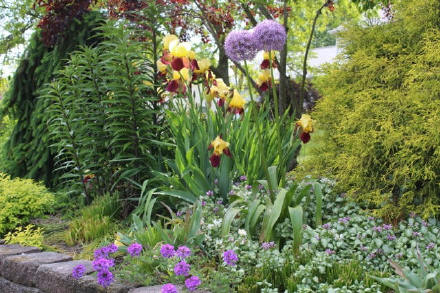(8/11) Nothing does a better job of adding eye-catching accents to your late spring garden than Alliums. Just when all the bulbs are finishing up their show, and the perennials and annuals are still developing, here come the Alliums along with the beloved iris to brighten up your life!
Most Alliums are sphere or globe-like flowers that bloom on leafless stems. They look like a flower version of a tootsie roll lollipop! Some spheres are densely packed, while others are loose and airy. They actually do have leaves. The foliage emerges first, and most species lie flat on the ground like a big spider. Some alliums such as the drumstick, emerge with
greens that resemble the wild onion that we work so hard to eradicate from our gardens. If you plant them, mark the spot so you don't mistake them for weeds in the spring.
Generally, alliums need lots of sun and good drainage. There are a few, like the Naples onion, that will take a little shade. Alliums come in short to tall sizes, and quite a variety of colors. My favorites are the big globes that grow anywhere up to 30" tall. Depending on the variety you choose, the globe might be 4" to 10 " across. If you look closely, you will see
that each globe is made up of hundreds of tiny star shaped flowers. You can find Alliums in shades of purple, lavender, blue, white, pink, and yellow.
 Alliums are bulbs, and like all spring flowering bulbs, they want to be planted in the fall. I prefer to buy my bulbs from a mail order company. They offer so many varieties, the pictures are great, and the catalogs always give good growing tips. Now is a good time to order before the supplies become limited.
Alliums will come back year after year, and they will multiply. Find a dry spot for them that does not tend to collect water in the winter. The larger the bulb, the quicker it will rot in wet soil. Plant alliums at a depth of two or three times the diameter of the bulb.
Alliums are bulbs, and like all spring flowering bulbs, they want to be planted in the fall. I prefer to buy my bulbs from a mail order company. They offer so many varieties, the pictures are great, and the catalogs always give good growing tips. Now is a good time to order before the supplies become limited.
Alliums will come back year after year, and they will multiply. Find a dry spot for them that does not tend to collect water in the winter. The larger the bulb, the quicker it will rot in wet soil. Plant alliums at a depth of two or three times the diameter of the bulb.
A great thing about alliums is that voles, rabbits and deer ignore them! They are members of the onion family and wildlife generally stay clear of these stronger scented plants and bulbs. Bees, butterflies, and other beneficial pollinators just love them! They are very showy in the garden, and also make a great cut flower.
Fertilize alliums with an organic bulb fertilizer twice a year - in the early spring, and again after they finish blooming. Even though the leaves become unsightly, allow them to stay intact so they can photosynthesize to strengthen next year's bulbs.
Because of their unattractive foliage, alliums look great with low growing perennials at their feet. A perennial such as Verbena 'Homestead purple' will camouflage the allium’s brown leaves. The allium flowers look stunning standing above it. This verbena is a zone 6 perennial that will spread about five feet wide, stay very low to the ground, and bloom purple flowers
all summer. Although it is a beautiful ground cover, Verbena 'Homestead purple’ can be short-lived. Even though it is rated as a zone 6 plant, it will often not survive our winters. I have had good luck with cutting it back in the late fall, and dumping a couple shovelfuls of compost on and around it. The compost protects the verbena, and feeds both the verbena and the
allium.
Another suggestion might be Nepeta 'Walker's low' which will begin flowering about the same time the allium blooms. This is a taller plant than the verbena, so only use it under very tall Alliums.
Garnet colored Drumstick Alliums wait a little later to bloom. They look amazing mixed in with Russian Sage. They will both bloom at the same time. A really spectacular allium is Schubertii which has a huge open flower on a rather short stem. They are a true conversation piece, and should be planted front and center. Try flowering thyme, a great ground-cover for the
sun, at their feet.
Our native Allium is the nodding onion, (Allium cernuum). About one foot tall, its rosy/lilac colored flower head hangs down gracefully like a little chandelier.
Now for the final fun fact about Alliums. Alliums are one of the only flowers I have found that do not turn to mush and fall to the ground when they are done. Instead, they lose their color, and become dry and very rigid. Buy a natural looking, or wild color spray paint (whatever your taste), hold a newspaper behind the plant to protect other plants, and spray away.
Presto! Your Allium season has just been extended through most of the summer!